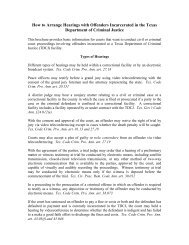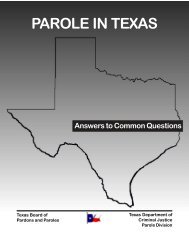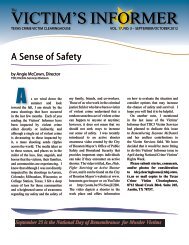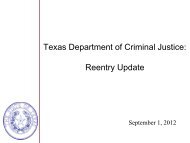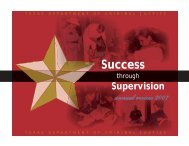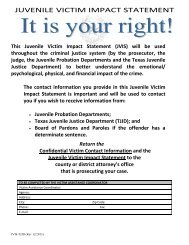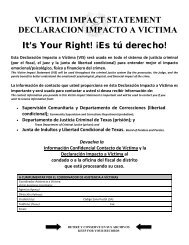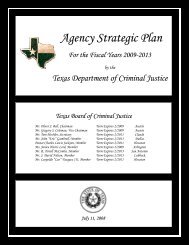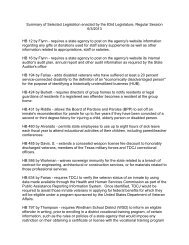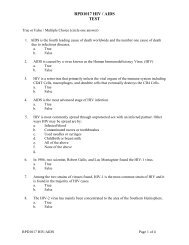Parole in Texas handbook - Texas Department of Criminal Justice
Parole in Texas handbook - Texas Department of Criminal Justice
Parole in Texas handbook - Texas Department of Criminal Justice
You also want an ePaper? Increase the reach of your titles
YUMPU automatically turns print PDFs into web optimized ePapers that Google loves.
What happens first <strong>in</strong> the process<br />
RELEASE AND SUPERVISION<br />
Several months before an <strong>of</strong>fender’s parole eligibility review date, an <strong>in</strong>stitutional parole<br />
<strong>of</strong>ficer <strong>in</strong>terviews the <strong>of</strong>fender. The parole <strong>of</strong>ficer prepares a case summary, which <strong>in</strong>cludes<br />
the facts <strong>of</strong> the <strong>of</strong>fender’s <strong>of</strong>fense; other relevant <strong>in</strong>formation such as assaultive behavior or<br />
the use <strong>of</strong> narcotics; personal history; assignments, adjustment, and discipl<strong>in</strong>ary record<br />
while <strong>in</strong> prison; physical and mental condition; and a summary <strong>of</strong> positive and negative<br />
factors are <strong>in</strong>cluded.<br />
Section 508.181 <strong>of</strong> the <strong>Texas</strong> Government Code states <strong>in</strong> part that a parole panel shall<br />
require as a condition <strong>of</strong> parole or mandatory supervision that an <strong>of</strong>fender reside (1) <strong>in</strong> the<br />
county where the <strong>of</strong>fender resided at the time <strong>of</strong> committ<strong>in</strong>g his or her <strong>of</strong>fense or (2) <strong>in</strong> the<br />
county where the <strong>of</strong>fender committed his or her <strong>of</strong>fense if the <strong>of</strong>fender was not a resident <strong>of</strong><br />
the state at the time <strong>of</strong> committ<strong>in</strong>g the <strong>of</strong>fense. In addition, a parole panel may require the<br />
<strong>of</strong>fender to reside <strong>in</strong> a county other than the <strong>of</strong>ficial county <strong>of</strong> residence to (1) protect the<br />
life and safety <strong>of</strong> a victim <strong>of</strong> the <strong>of</strong>fense, the <strong>of</strong>fender, a witness <strong>in</strong> the case or any other<br />
person, or (2) <strong>in</strong>crease the likelihood <strong>of</strong> the <strong>of</strong>fender’s successful completion <strong>of</strong> parole or<br />
mandatory supervision.<br />
Who makes the decision to grant parole<br />
As the <strong>of</strong>fender’s parole eligibility review date approaches, a parole panel (Board <strong>of</strong> Pardons<br />
and <strong>Parole</strong>) reviews the <strong>of</strong>fender’s case. The <strong>of</strong>fender may be <strong>in</strong>terviewed by one <strong>of</strong> the panel<br />
members before the f<strong>in</strong>al panel vote. The panel is composed <strong>of</strong> at least one board member<br />
and any comb<strong>in</strong>ation <strong>of</strong> board members and parole commissioners, and two <strong>of</strong> the three<br />
panelists must vote for parole before it can be granted. A few categories <strong>of</strong> <strong>of</strong>fenders may be<br />
paroled only upon a two-thirds majority vote <strong>of</strong> the entire seven-member board. (See Senate<br />
Bill 45.)<br />
What do decision-makers consider before grant<strong>in</strong>g parole<br />
<strong>Parole</strong> panel members look at the circumstances and seriousness <strong>of</strong> the <strong>of</strong>fense; prior<br />
prison commitments; relevant <strong>in</strong>put from victims, family members, and trial <strong>of</strong>ficials;<br />
adjustment and attitude <strong>in</strong> prison; the <strong>of</strong>fender’s release plan; and factors such as alcohol<br />
or drug use, violent or assaultive behavior, deviant sexual behavior, use <strong>of</strong> a weapon <strong>in</strong> an<br />
<strong>of</strong>fense, <strong>in</strong>stitutional adjustment, and emotional stability. Based on the entirety <strong>of</strong> the<br />
available <strong>in</strong>formation, the parole panel then determ<strong>in</strong>es whether the <strong>of</strong>fender deserves the<br />
privilege <strong>of</strong> parole.<br />
What are the <strong>Parole</strong> Guidel<strong>in</strong>es<br />
<strong>Parole</strong> Guidel<strong>in</strong>es consist <strong>of</strong> two major components that <strong>in</strong>teract to provide an <strong>of</strong>fender’s<br />
probability <strong>of</strong> parole success. The first is a Risk Assessment Instrument that weighs both<br />
static and dynamic factors associated with the <strong>of</strong>fender’s record. Static factors <strong>in</strong>clude age<br />
at first admission to a juvenile or adult correctional facility, history <strong>of</strong> supervisory release<br />
59





